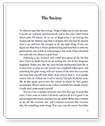Search And Seizure Essays and Research Papers
Instructions for Search And Seizure College Essay Examples
Title: Search and Seizure
Total Pages: 10 Words: 3475 Bibliography: 0 Citation Style: APA Document Type: Essay
Title: compare and contrast case laws on search and seizures
Total Pages: 8 Words: 2244 Sources: 0 Citation Style: MLA Document Type: Research Paper
Title: criminal procedure
Total Pages: 12 Words: 3499 References: 10 Citation Style: APA Document Type: Essay
Title: 4th Amendment Search and Seizure
Total Pages: 7 Words: 1995 Works Cited: 7 Citation Style: MLA Document Type: Research Paper


